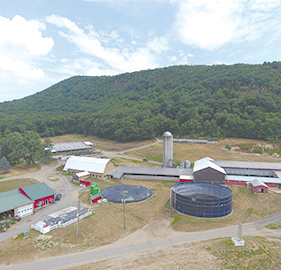When you throw your food scraps into the town dumpster at 42 Ffyler Place, you free up landfill space and prevent destructive methane gas from entering the atmosphere. But that’s just the beginning of the good you’re doing for the environment.
Suffield’s garbage hauler empties the dumpster at an organics recycling plant in Agawam owned by Vanguard Renewables, an organic waste-to-renewable energy company. There, machinery removes impurities such as plastic, glass, metal utensils and packaging.
Inside the recycling plant
According to Vanguard co-founder John Hanselman, the plant accepts food scraps from towns like Suffield, food producers and grocers, including Cabot Creamery, Geissler’s Supermarkets, HP Hood, Coca-Cola and Whole Foods. They contribute off-spec, expired or otherwise unsafe food, along with pallets of beer, milk and soda. Cafeteria plate scrapings come from schools like Suffield’s Spaulding Elementary, UMass Amherst and Smith College, while area restaurants provide food scraps and grease trap waste.
After Vanguard separates impurities, it ships the food scraps to four anaerobic digesters, which it owns and operates on farms in Massachusetts and Vermont, said Hanselman. The digesters mix the scraps with cow manure to produce methane, organic fertilizer and animal bedding.
What is an anaerobic digester?
Consider the farm digester closest to Suffield, at Barstow’s Longview Farm in Hadley, Massachusetts. It runs continuously, year-round and receives food scraps from Agawam.

At Barstow’s Longview Farm in Hadley, Massachusetts, an energy company leases land and owns, operates and maintains an anaerobic digester that uses manure and food scraps.
At its core is an in-ground, heated 600,000-gallon tank where food scraps mix with the farm’s cow manure in a zero-oxygen atmosphere, hence the term anaerobic. According to farm Education Manager Denise Barstow Manz, the farm’s 550 cows each produce about 100 lbs of manure daily.
Microbes chew on the sugars, fats and other compounds inside the digester to create methane. As the methane accumulates, it rises to the top of the digester.
It’s piped to a purifying station and then becomes the fuel for two engines, which spin two generators that produce renewable electricity.
Odor reduction, organic fertilizer and more
According to Hanselman, the process removes about 90% of the manure’s odor. “It makes all the downwind neighbors really happy,” he said. “They love us.”
Hot water from the generators’ cooling system warms up water in pipes that provide heat to the digester, barn, farm homes, and even some neighboring homes.
Barstow Manz said the farm consumes only about 4% of the electricity. The rest goes into the electrical grid to power about 1,600 average-size homes.
Hanselman said that once the methane is removed, a semi-solid liquid that resembles oatmeal remains in the digester. The liquid is pressed out, and the dried portion becomes animal bedding. Since it contains the same microbes as in the cows’ stomachs, “the incidence of mastitis and infection has dropped off massively,” he noted. Mastitis is a contagious cow udder infection that reduces milk yield and quality.
The remaining liquid byproduct is a low-carbon, chemical-free organic fertilizer superior to conventional fertilizer. (In the accompanying photo, it’s stored in the blue, circular, open-topped tank shown at the center.)
“Traditionally, a New England farmer is really happy if they get three to four cuttings of their hay,” said Hanselman. “Using our organic fertilizer, our farms are getting four to six cuttings of hay. The yield per acre is going up anywhere from 30% to 50%, and the nutritional value is going up anywhere between 15% and 25%. So you’re making more and better hay, corn and alfalfa for the animals.”
Furthermore, according to company literature, the entire process prevents as much carbon dioxide from entering the atmosphere annually as is used by 650 average-size cars in one year.
And it all begins when you pitch your food waste into the dumpster at 42 Ffyler Place. Here’s a tip from John Hanselman: freezing food scraps lets you accumulate more, odor-free, without attracting insects.